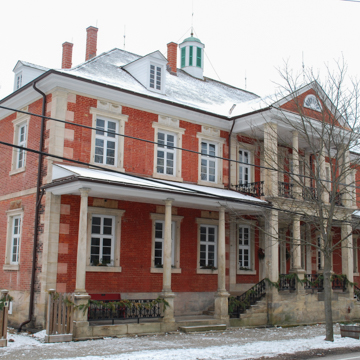The Village of Zoar was home to the Society of Separatists of Zoar from 1817 to 1898. In the village, this religious utopian society created a comprehensive built environment to support their communal lifestyle and reflect their German cultural traditions.
Most houses in the village of Zoar were given numbers to aid in the efficient distribution of supplies. Number One House was constructed in 1835 to serve as a communal home for elderly Zoarites. Located near the Zoar Hotel and the General Store, Number One House was placed near the new village’s commercial hub for convenience of its intended residents. The retirement home concept was quickly abandoned, when aging members of the community decided to remain in their own residences. Number One House was offered, instead, to Joseph Bimeler, the Separatists’ long-time leader, for his dedication to the Zoarite community.
The house Bimeler moved into is more imposing than the other buildings in the village, combining typical nineteenth-century classicism with references to German Renaissance architecture reflective of the Zoarites’ native country. It was built on a raised foundation and constructed of Flemish-bond brick with sandstone quoins and embedded pilasters. Number One House’s most notable feature is a raised entrance portico, composed of a two-story pedimented porch, which is centered on the facade. The building has gabled dormers within the roof and an octagonal cupola. The design of Number One House is similar in appearance to buildings that still stand in Württemberg, the region of Germany that the Zoarites fled due to religious persecution. Other Germanic details include the large vaulted cellar with brick paved floor and post-and-beam framing that is visible in the attic space. This was a traditional construction technique of central Europe.
German immigrants had been bringing their building traditions to America since the late 1600s, and between 1680 and 1780, they extended their influence from Pennsylvania as far west as Wisconsin and as far south as North Carolina. Arriving decades after the major period of German settlement, the Zoarites kept their homeland culture intact, in part, by incorporating their architectural traditions as part of their life and religion.
The Zoar Historical Society, formed in 1930, started a museum in the building, showcasing artifacts from the former utopia. The Ohio State Archaeological and Historical Society became involved with the museum, ultimately purchasing it in 1941. Restoration and reconstruction efforts by the Ohio Historical Society has been supported by historic research. The 1930s Historic American Building Survey (HABS) documentation, in particular, has served to provide a blueprint for directing preservation-related construction. The building continues to function as a museum.
House Number One is included in the Zoar Historic District, which was designated a National Historic Landmark in 2016.
References
Avdakov, Steven, Debbie Griffin, and Nathalie Wright, “Zoar Historic District,” Tuscarawas County, Ohio. National Historic Landmark Nomination, 2016. National Park Service, U.S. Department of the Interior, Washington, D.C.
Fernandez, Kathleen M. A Singular People: Images of Zoar. Kent, OH: Kent State University Press, 2003.
Hinds, William Alfred. American Communities. Rev. ed. Chicago: Charles H. Kerr and Company, 1902.
Morhart, Hilda Dischinger. The Zoar Story. Dover, OH: Seibert Printing Company, 1967.
Nixon, Edgar Burkhardt. “The Society of Separatists of Zoar.” Ph.D. dissertation, The Ohio State University, 1933.
Nordhoff, Charles. Communistic Societies of the United States. New York: Harper and Brothers, 1875.
Robison, Elwin C. “Heavenly Aspirations and Earthly Realities: Four Northeast Ohio Religious Utopias.” Timeline 17, no. 6 (November/December) 2000: 2-25.

